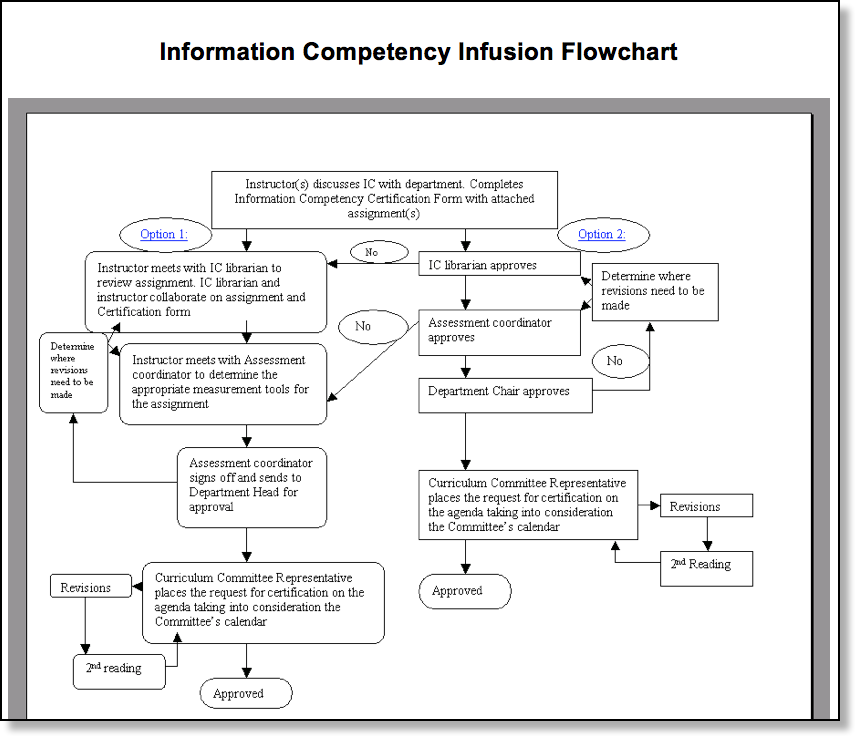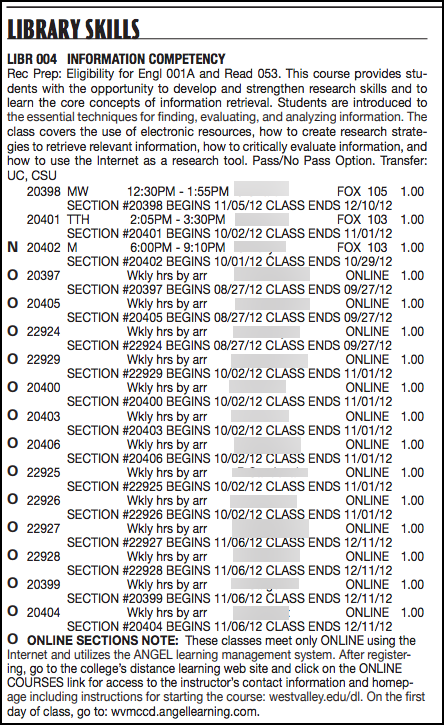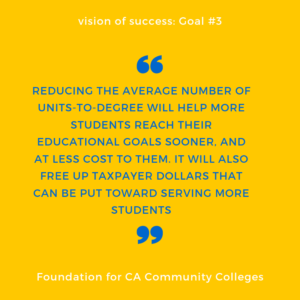In the beginning
 When I first started teaching Library 4, a 1-unit information competency course (in CA community colleges we call information literacy information competency) in 2005, there was just one section offered per semester and I barely had 5-10 students per class. The college let me teach it because I needed the experience since I was a very green instructor.
When I first started teaching Library 4, a 1-unit information competency course (in CA community colleges we call information literacy information competency) in 2005, there was just one section offered per semester and I barely had 5-10 students per class. The college let me teach it because I needed the experience since I was a very green instructor.
By 2006, Library 4 was officially a local graduation requirement and suddenly additional sections were scheduled, associate librarians hired, and we were able to offer it both on ground and online. Library 4 was going strong and the Library decided to approach the Academic Senate with a new additional requirement that would further inculcate information competency across the curriculum. It was approved and so the information competency (infocomp) graduation requirement became the following:
1. Students must take Library 004, Information Competency (6 weeks)
2. Students must take 2 subject discipline courses infused with elements of information competency

OK, maybe we got a bit ahead of ourselves with the infusion idea, but there seemed to be a lot of campus support for this measure based upon the successful rollout of Library 4. It was a model for collaborative teamwork between library and subject discipline faculty. Our discussions evolved into the potential for deep learning and thinking and fostered the enhancement of assignments. What may have at first been a simple paper with the requirement of three resources for the bibliography, may have evolved into a project requiring the use of primary resources such as interviews, government reports or archival material—giving students a myriad of choices that they never would have read, touched or integrated without these faculty brainstorming sessions. Alas, that half of the requirement only lasted a few years because we just couldn’t get enough classes to sign on and the infusion requirement was becoming a burden for students to complete.
We should have seen the writing on the wall
The promise of infused classes may have been realized if a “no infusion movement” hadn’t spread within some of the college divisions. I was privy to conversations within division meetings where departments who  were competing for student enrollment mutually agreed not to participate in the infocomp infusion process so that a course that was infused would not have an advantage over other courses for enrollment. For example, Psych 1 competes with Econ1, and Anthro 1 for IGETC credits toward a Poli Sci degree. If one of these classes infused and the others didn’t, the former would have an advantage in attracting students. And so it goes. Politics is alive and well in academia!
were competing for student enrollment mutually agreed not to participate in the infocomp infusion process so that a course that was infused would not have an advantage over other courses for enrollment. For example, Psych 1 competes with Econ1, and Anthro 1 for IGETC credits toward a Poli Sci degree. If one of these classes infused and the others didn’t, the former would have an advantage in attracting students. And so it goes. Politics is alive and well in academia!
Information Competency is an Institutional Learning Outcome
As an institutional learning outcome for the college, we were determined to make Library 4 a great success — and we did.
The library offered 16 sections in fall, 2012.

Our successful completion numbers were similar to other classes (in the 60 percentile range) until we made the concerted effort to really transform the online version. We had a number of associate librarians on the team and each brought a unique take on how the class should be organized in order to meet the student learning outcomes. This was our strength. Our success rate went from 60% to 75% within a few semesters. In the meantime, we reached out to Counseling and requested that they recommend Library 4 to students in their first semester or recommend students take the class at the same time they took English 1A. The two classes would integrate well together and students would be able to use what they learned in Library 4 to help them with their final research project for English 1A.
A bump in the road for Library 4, but well worth it for students
All was going well and then SB 1440 happened –The Student Transfer Achievement Act signed into legislation in 2010 and eventually implemented across the CA community colleges in 2011-2012. The legislation paved the way for community college students to achieve an ADT (Associate Degree for Transfer) to the CSU’s with junior standing. This law has been an important step in increasing student graduation and transfer rates and I am a great supporter of it; however, as a condition of the law, colleges could no longer impose local graduation requirements:
…As a condition of receipt of state apportionment funds, a community college district … shall not impose any requirements in addition to the requirements of this section, including any local college or district requirements, for a student to be eligible for the associate degree for transfer and subsequent admission to the California State University pursuant to Section 66747. —Senate Bill 1440
And so in 2012, Library 4 was removed as a graduation requirement for students working toward an ADT. It was still in place for the AA/AS degree, and students continued to flock to the course, but, over time, students were counseled to work toward and ADT. Thus, enrollment has been steadily falling ever since.
Today
The college has been offering 5 sections of Library 4 per semester over the last 1-2 years. All was going well until April 2019 when our Counseling Department recommended to the Curriculum Committee and Academic Senate that Library 4 should be completely removed as a graduation requirement. Both committees unanimously approved.
What happened between 2012 and now? What could we have done differently to keep Library 4 at the forefront and a valuable addition to our curriculum? After all, our success rates were high and we received great feedback from our students over the years. Faculty would comment on how students sung the praises of Library 4 in their classes. I am biased, of course. I am very invested in Library 4. Over the years it went through numerous iterations to meet the changing information landscape and the librarians worked hard to make sure we focused on enhancing skills that would be relevant to a student’s chosen field of study. So, yes, I do have a wee chip on my shoulder, but I’ll get over it.
What’s next
There are several reasons behind the removal of Library 4 and many of them are beyond the library’s control. The Vision for Success announced by California Community College Chancellor Oakley focuses on six goals to streamline a student’s community college experience and reduce achievement and equity gaps.  One of them is ” to decrease the average number of units accumulated by California Community College students earning associate degrees.” As a local requirement, Library 4 is a 1-unit skills class. That’s an extra unit that can easily be cut. It can and should be remixed and integrated into the subject disciplines if there is the will to do it. California’s Guided Pathways Project is another exciting movement where information competency skills can be strategically targeted in multiple positions on a student’s pathway.
One of them is ” to decrease the average number of units accumulated by California Community College students earning associate degrees.” As a local requirement, Library 4 is a 1-unit skills class. That’s an extra unit that can easily be cut. It can and should be remixed and integrated into the subject disciplines if there is the will to do it. California’s Guided Pathways Project is another exciting movement where information competency skills can be strategically targeted in multiple positions on a student’s pathway.
After my experience with the infusion process all those years ago, I know we librarians will have to introduce modules that are easily integrated without more work for the instructors and which also align smoothly with class projects. We’re already doing it with LibGuides and their integration into Canvas, our learning management system, but we’ll need to be more targeted, more proactive and have options and examples to show instructors how much better the student experience can be when they have the information, technology and communication skills embedded in the curriculum.
Library 4 may be back to being only offered once a semester and that’s OK. We will take its best aspects to create new and innovative learning opportunities for our students.
Attributions
Image:“Future I’m Ready” by Gerd Altmann, Pixabay is in the Public Domain, CC0
Image: “No Infusion Zone” created using PhotoFunia on iPhone.
